 W
WThe Annunciation Triptych is an oil-on-panel triptych by the Netherlandish artist Rogier van der Weyden, dating from around 1434. It was originally formed by three panels, the central one being now at The Louvre museum in Paris, France; the side panels are at the Galleria Sabauda of Turin, northern Italy.
 W
WThe Archangel Raphael Leaving Tobias' Family is a 1637 oil-on-panel painting by Rembrandt, now in the Louvre, in Paris, France.
 W
WThe Arrival of Marie de Medici at Marseilles is a c. 1622-1625 Baroque painting done by Sir Peter Paul Rubens. It was commissioned by Marie de' Medici of France to commemorate the life of her and her husband Henry IV of France. This painting was one of the 24 paintings in the Marie de' Medici cycle by Rubens. The painting currently resides in the Louvre in Paris.
 W
WThe Astronomer is a painting finished in about 1668 by the Dutch Golden Age painter Johannes Vermeer. It is in oil on canvas, 51 cm × 45 cm, and is on display at the Louvre, in Paris, France.
 W
WBathsheba at Her Bath is an oil painting by the Dutch artist Rembrandt (1606–1669) finished in 1654.
 W
WThe Beggars or The Cripples is an oil-on-panel by the Netherlandish Renaissance artist Pieter Bruegel the Elder, painted in 1568. It is now in the Louvre in Paris.
 W
WThe Braque Triptych is a c. 1452 oil-on-oak altarpiece by the Early Netherlandish painter Rogier van der Weyden. When open, its three half-length panels reveal, from left to right, John the Baptist, The Virgin Mary with Jesus and Saint John the Evangelist, and on the right, Mary Magdalene. When the wings are closed, the work shows a vanitas motif of a skull and cross.
 W
WCard Players in a Rich Interior is a c. 1663 – 1665 oil on canvas painting by Pieter de Hooch, produced at the start of his time in Amsterdam and signed "P. D. HOOCH". It is now in the Louvre, whose collections it entered in 1801.
 W
WCatharina Both van der Eem is a painting by the Dutch Golden Age painter Frans Hals, painted in 1620 and now in Louvre Museum. It is considered a pendant portrait to the Portrait of Paulus van Beresteyn, in the same museum.
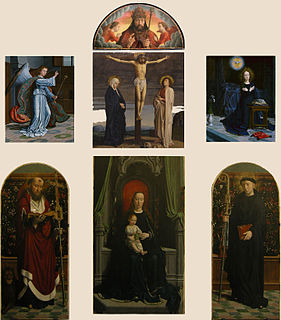 W
WThe Cervara Altarpiece or Cervara Polyptych was an oil-on-oak-panel altarpiece painted by the Flemish painter Gerard David early in the 16th century for the high altar of Cervara Abbey in Liguria, Italy.
 W
WCharles I at the Hunt – also known under its French title, Le Roi à la chasse – is an oil-on-canvas portrait of Charles I of England by Anthony van Dyck c. 1635, now in the Louvre Museum, Paris. It depicts Charles in civilian clothing and standing next to a horse as if resting on a hunt, in a manner described by the Louvre as a "subtle compromise between gentlemanly nonchalance and regal assurance".
 W
WCrucifixion with the Virgin Mary, St John and St Mary Magdalene is a painting by Anthony van Dyck. He produced it in 1617-19 as the high altarpiece for the Jesuit church in Bergues near Dunkirk, during his time as an assistant to Peter Paul Rubens - for a long time the painting was even attributed to Rubens. It was paid to Rubens in 1621 and seems to have been sold around 1746. It was bought by Louis XV of France in Antwerp in 1749 to be the high altarpiece of Saint-Louis de Versailles at the Palace of Versailles. It is now in the Louvre.
 W
WThe Diptych of an elderly couple is a pair of bust-length wedding portraits by Hans Memling, which were formerly attached with pegs and were split some time before they were sold separately in 1894. One is in the collection of the Gemäldegalerie and the other is in the collection of the Louvre. When viewed side by side the landscape background joins up to form a whole.
 W
WDune Landscape near Haarlem, also known as The Bush and The Thicket near Haarlem, is an oil on canvas painting by the Dutch Golden Age painter Jacob van Ruisdael. It is in the collection of the Louvre in Paris.
 W
WThe Four Evangelists is an oil on canvas painting by the Flemish Baroque artist Jacob Jordaens, completed in 1625. The painting is 133 by 118 centimeters. and is in the Musée du Louvre, Paris, France.
 W
WFrancesca da Rimini and Paolo Malatesta appraised by Dante and Virgil is a composition painted in at least six very similar versions by Ary Scheffer between 1822 and 1855; all are in oils on canvas. The paintings show a scene from Dante's Inferno, of Dante and Virgil in the shadows to the right viewing the murdered lovers Francesca da Rimini and Paolo Malatesta in Hell. It "could be described as Scheffer's best work".
 W
WThe Gypsy Girl is a painting by the Dutch Golden Age painter Frans Hals, painted in 1628 and now in the Louvre Museum. It is a tronie, a study of facial expression and unusual costume, rather than a commissioned portrait. The display of cleavage was not a common feature of costume seen in public in Hals' time and place.
 W
WHelena Fourment with a carriage is a 1639 painting by Peter Paul Rubens, showing his second wife Helena Fourment, their son Frans and a carriage.
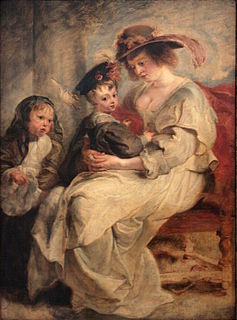 W
WHelena Fourment with Children is a c.1636 painting by Peter Paul Rubens, showing his second wife Helena Fourment with their son Frans in her arms and their daughter Clara Johanna standing to their left. It was acquired by Louis XVI of France in 1784 and is now in the Louvre Museum in Paris.
 W
WHercules and Omphale is a circa 1602 painting by Peter Paul Rubens, now held in the Louvre Museum in Paris.
 W
WIxion, king of the Lapiths, deceived by Juno is a painting by Peter Paul Rubens, executed c. 1615. It was part of the Duke of Westminster's collection in the 19th century, before passing to baron Basile de Schlichting, who left it to the Louvre Museum in 1914.
 W
WThe King Drinks or The Bean King may refer to one of ten surviving works of the same title by Jacob Jordaens:The King Drinks (Brussels), one of two in that museum The King Drinks Galerie Heim, Basel Brunswick Kassel Chatsworth House Paris (Louvre) Lille Valenciennes Vienna
 W
WThe Lacemaker is a painting by the Dutch artist Johannes Vermeer (1632–1675), completed around 1669–1670 and held in the Louvre, Paris. The work shows a young woman wearing a yellow bodice, holding up a pair of bobbins in her left hand as she carefully places a pin in the pillow on which she is making her bobbin lace. At 24.5 cm x 21 cm, the work is the smallest of Vermeer's paintings, but in many ways one of his most abstract and unusual. The canvas used was cut from the same bolt as that used for A Young Woman Seated at the Virginals, and both paintings seem to have had identical dimensions originally.
 W
WLamentation (Pietà) is an oil painting on panel of the common subject of the Lamentation of Christ that is now regarded as by an artist in the "circle" of the Early Netherlandish painter Petrus Christus, rather than by Christus himself. It was painted in c. 1444, and is now in the Louvre in Paris.
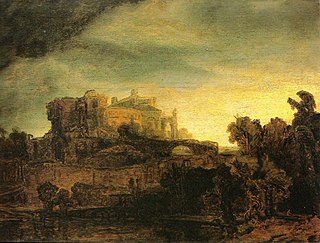 W
WLandscape with a Castle is a painting by Rembrandt, now in the Louvre in Paris. Art historians have variously dated it to 1652, 1654, early 1640, 1648, 1640-1642, c.1640 and 1643-1646.
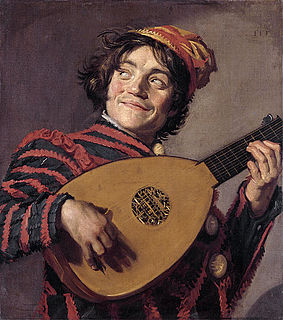 W
WThe Lute Player refers to a painting from 1623 or 1624 now in the Louvre by the Haarlem painter Frans Hals, showing a smiling actor wearing a jester's costume and playing a lute.
 W
WMadonna and Child with Two Donors or The Madonna of the Two Donors is a 1630 painting by Anthony van Dyck, now in the Louvre.
 W
WThe Madonna of Chancellor Rolin is an oil painting by the Early Netherlandish master Jan van Eyck, dating from around 1435. It is kept in the Musée du Louvre, Paris, and was commissioned by Nicolas Rolin, aged 60, chancellor of the Duchy of Burgundy, whose votive portrait takes up the left side of the picture, for his parish church, Notre-Dame-du-Chastel in Autun, where it remained until the church burnt down in 1793. After a period in Autun Cathedral, it was moved to the Louvre in 1805.
 W
WThe Marie de' Medici Cycle is a series of twenty-four paintings by Peter Paul Rubens commissioned by Marie de' Medici, widow of Henry IV of France, for the Luxembourg Palace in Paris. Rubens received the commission in the autumn of 1621. After negotiating the terms of the contract in early 1622, the project was to be completed within two years, coinciding with the marriage of Marie's daughter, Henrietta Maria. Twenty-one of the paintings depict Marie's own struggles and triumphs in life. The remaining three are portraits of herself and her parents. The paintings now hang in the Louvre in Paris.
 W
WThe Money Changer and His Wife is a 1514 oil on panel painting by the Flemish renaissance artist Quentin Matsys.
 W
WMountainous Landscape with a Bridge and Four Horsemen is an oil painting on panel by the Flemish painter Joos de Momper. Its date of execution is unknown. The painting was once attributed to Paul Bril. It is part of the permanent collection of the Louvre in Paris.
 W
WMountainous Landscape with a Bridge and Four Horsemen is an oil painting on canvas by the Flemish landscapist Joos de Momper. Its date of execution is unknown. The painting is kept in the Louvre in Paris.
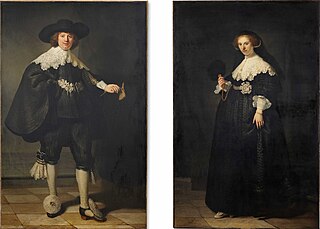 W
WThe pendant portraits of Marten Soolmans and Oopjen Coppit are a pair of full-length wedding portraits by Rembrandt. They were painted on the occasion of the marriage of Marten Soolmans and Oopjen Coppit in 1634. Formerly owned by the Rothschild family, they became joinedly owned by the Louvre Museum and the Rijksmuseum in 2015 after both museums managed to contribute half of the purchase price of €160 million, a record for works by Rembrandt.
 W
WPerseus Freeing Andromeda is a 1611 oil on canvas painter by the Dutch Mannerist painter Joachim Wtewael. Since 1982 it has been in the collection of the Louvre in Paris. A preparatory drawing for it also survives in the Albertina in Vienna, reprising the pose in the same artist's St Sebastian Bound to a Tree for Andromeda. In the final painting he used a less curving and more supple pose for Andromeda.
 W
WPhilosopher in Meditation is the traditional title of an oil painting in the Musée du Louvre, Paris, that has long been attributed to the 17th-century Dutch artist Rembrandt.
 W
WHans Holbein the Younger painted the Portrait of Erasmus of Rotterdam several times, and his paintings were much copied, at the time and later. It is difficult to disentangle Holbein's original work from that of his workshop and other copyists. Possibly five largely original versions survive, as well as a number of drawings made as studies.
 W
WThe pendant portraits of Marten Soolmans and Oopjen Coppit are a pair of full-length wedding portraits by Rembrandt. They were painted on the occasion of the marriage of Marten Soolmans and Oopjen Coppit in 1634. Formerly owned by the Rothschild family, they became joinedly owned by the Louvre Museum and the Rijksmuseum in 2015 after both museums managed to contribute half of the purchase price of €160 million, a record for works by Rembrandt.
 W
WPortrait of Nicolaus Kratzer is a 1528 half-length oil on canvas portrait by Hans Holbein the Younger. It is now in the Louvre, whilst a copy after it hangs in the National Portrait Gallery. It shows the astronomer Nikolaus Kratzer, a friend of Thomas More and Holbein himself. In his hand he holds a half-finished polyhedral sundial, whilst on the shelves behind him are a semi-circular star quadrant, a shepherd's dial and other instruments.
 W
WThe pendant portraits of Marten Soolmans and Oopjen Coppit are a pair of full-length wedding portraits by Rembrandt. They were painted on the occasion of the marriage of Marten Soolmans and Oopjen Coppit in 1634. Formerly owned by the Rothschild family, they became joinedly owned by the Louvre Museum and the Rijksmuseum in 2015 after both museums managed to contribute half of the purchase price of €160 million, a record for works by Rembrandt.
 W
WPortrait of the Artist Holding a Thistle is an oil painting on parchment pasted on canvas by German artist Albrecht Dürer. Painted in 1493, it is the earliest of Dürer's painted self-portraits and has been identified as one of the first self-portraits painted by a Northern artist. It was acquired in 1922 by the Louvre in Paris.
 W
WThe Ray of Light, also known as Le Coup de Soleil, is an oil on canvas painting by the Dutch painter Jacob van Ruisdael. It is an example of Dutch Golden Age painting and is now in the collection of the Louvre Museum.
 W
WSelf-Portrait or Self-Portrait with an Architectural Background is a c.1639 oil on panel self-portrait by Rembrandt, now in the Louvre in Paris. It was bought by the art dealer Alexandre Joseph Paillet in London in 1785 for the collection of Louis XVI.
 W
WShip of Fools is a painting by Hieronymus Bosch, now on display in the Musée du Louvre, Paris. The surviving painting is a fragment of a triptych that was cut into several parts. The Ship of Fools was painted on one of the wings of the altarpiece, and is about two-thirds of its original length. The bottom third of the panel belongs to Yale University Art Gallery and is exhibited under the title Allegory of Gluttony. The wing on the other side, which has more or less retained its full length, is the Death and the Miser, now in the National Gallery of Art, Washington, D.C. The two panels together would have represented the two extremes of prodigality and miserliness, condemning and caricaturing both. The Wayfarer was painted on the right panel rear of the triptych. The central panel, if existed, is unknown.
 W
WSlaughtered Ox, also known as Flayed Ox, Side of Beef, or Carcass of Beef, is a 1655 oil on beech panel still life painting by Rembrandt. It has been in the collection of the Louvre in Paris since 1857. A similar painting is in Kelvingrove Art Gallery and Museum, Glasgow, possibly by Rembrandt himself but probably by one of his pupils, perhaps Fabritius. Other similar paintings by Rembrandt or more likely his circle are held by museums in Budapest and Philadelphia.
 W
WSt. Matthew and the Angel is an oil on canvas painting by the Dutch landscape painter Rembrandt. It is an example of Dutch Golden Age painting and is now in the collection of the Louvre.
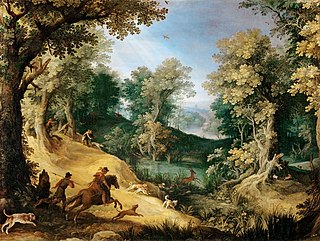 W
WStag Hunt is an oil on canvas painting by Flemish painter Paul Bril. It was probably painted in the 1590s, and is currently housed at the Louvre in Paris. The painting was once part of the collection of Louis XIV.
 W
WStorm Off a Sea Coast, also known as The Breakwater, is a 1670 oil on canvas painting by the Dutch Golden Age painter Jacob van Ruisdael. It is in the collection of the Louvre in Paris.
 W
WSupper at Emmaus or The Pilgrims at Emmaus is a 1648 oil on mahogany panel painting by Rembrandt. It was sold at the sale of the collection of Willem Six on 12 May 1734 in Amsterdam and then at three Paris sales before finally being acquired for the French royal collection in 1777 at a fourth sale. It is now in the Louvre in Paris.
 W
WThe Tree of Crows is an oil painting of 1822 by the German Romantic artist Caspar David Friedrich. Acquired by the Musée du Louvre in 1975, it has been called one of Friedrich's "most compelling paintings."
 W
WTriptych of the Sedano family is an oil-on-panel triptych altarpiece by the Early Nethlandish painter Gerard David, usually dated between 1490 and 1498, probably c. 1495. It is noted for its innovative framing and for its rendering of the decorative oriental carpet seen at Mary's feet.
 W
WThe Vegetable Market in Amsterdam (c.1660–61) is an oil on canvas painting by the Dutch painter Gabriël Metsu, it is an example of Dutch Golden Age painting and is part of the collection of the Louvre.
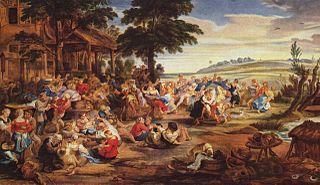 W
WThe Village Fête, La Kermesse or Noce de village. is a painting by Peter Paul Rubens, created in 1635-1638, now held in the Louvre Museum. It shows a 'kermesse' or village wedding.
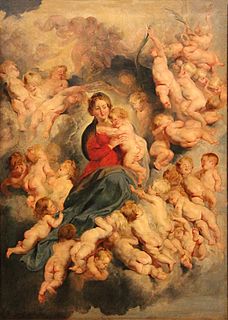 W
WThe Virgin and Child surrounded by the Holy Innocents or The Virgin and Child with Angels is a 1616 oil painting by Peter Paul Rubens, showing the Virgin and Christ Child with the Holy Innocents. It was originally produced as oil on panel, before being transferred to canvas. In 1671 it was acquired from a Monsieur de la Feuille by Louis XIV and is now in the Louvre Museum.